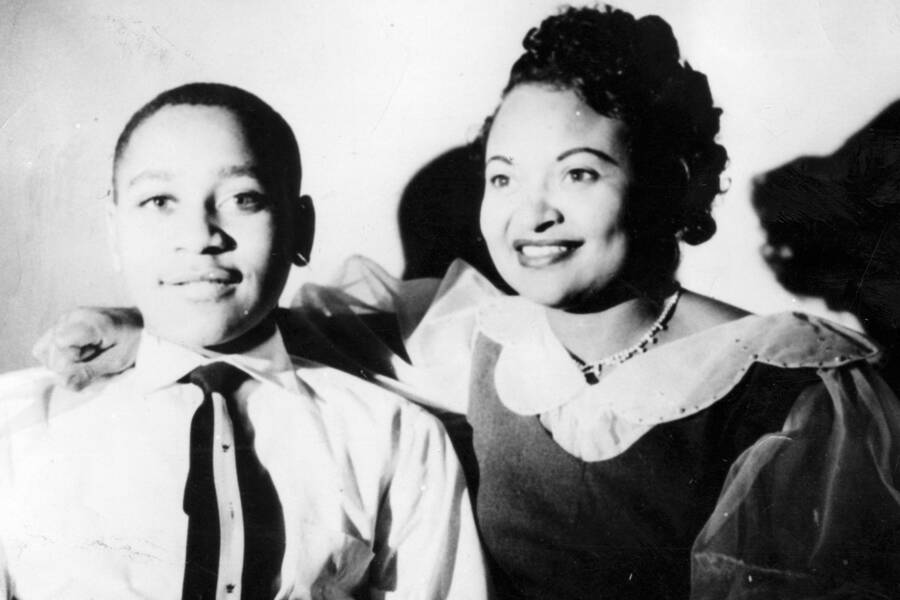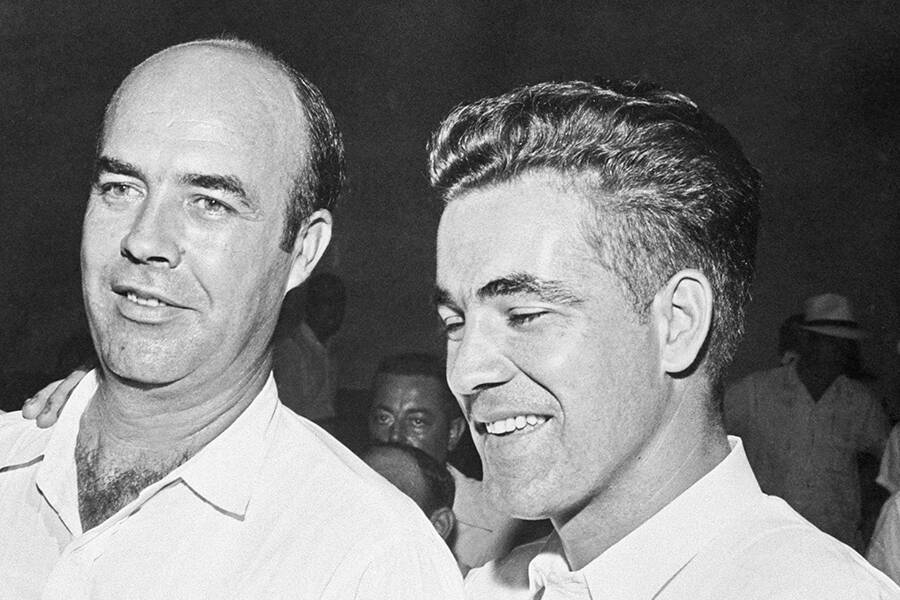Mamie Till-Mobley is best known for her activism after her son's murder in 1955. But her story didn't end there.
On August 31, 1955, the body of 14-year-old Emmett Till was found in the Tallahatchie River in Mississippi. His corpse was so mutilated that he could only be identified by his ring. And Emmett Till’s mother, Mamie Till-Mobley, was devastated when she found out what happened to him.
A few days earlier, Emmett had been abducted, tortured, and murdered by two white men, Roy Bryant and J.W. Milam. They were enraged to hear that the Black teenager had allegedly sexually harassed Bryant’s wife, Carolyn. (Decades later, Carolyn Bryant admitted that her accusation was a lie.)

Getty ImagesEmmett Till’s mother, Mamie Till-Mobley, never imagined she’d become an activist.
As devastated as Mamie Till-Mobley was by her son’s murder, she knew that he was far from the only victim of a racially-motivated attack in Jim Crow America. And although she had never intended to become an activist, she soon found herself thrust into the nascent civil rights movement.
The Early Life Of Mamie Till-Mobley
On November 23, 1921, Mamie Elizabeth Carthan was born near Webb, Mississippi — not far from where her son would eventually be murdered. But she didn’t stay in the South for long. When she was two years old, she and her family moved to the Chicago area, and they settled in Argo, Illinois.
But despite the family’s move to the North, they still had relatives in Mississippi, whom they often spent their summers visiting. During one of these trips, Mamie encountered one of her first experiences of racial injustice, according to the National Parks Conservation Association.
At 12 years old, Mamie noticed that her grandparents were using a catalog as toilet paper. She went to a nearby drugstore to purchase real toilet paper, but the store’s white owner refused to sell her any. Sensing that Mamie was about to argue, her grandfather pulled her away and, she later recalled, “pounded the fear of every Black person in the state of Mississippi into [her].”

Getty Images Emmett Till’s mother with Moses Wright, her son’s great-uncle.
That fear lingered in the back of her mind as she grew older. After she graduated high school — as the first Black student to make the “A” honor roll in her class — she met Louis Till. On their first date, they got ice cream, and Louis made a point of sitting inside the white-owned store while they ate.
Black passersby who saw Mamie and Louis sitting inside enjoying a banana split followed their example. And soon enough, the booths inside the store were filled with Black customers. Mamie feared her mother would find out about what they did, but thankfully, nothing bad happened as a result.
Unfortunately, Louis and Mamie’s relationship wasn’t the fairytale it seemed. They married and had a son named Emmett in 1941, but Louis soon became an abusive partner, and Mamie ultimately filed a court order against him when Emmett was just a few months old. Louis was then given the choice between prison or the army — and ended up choosing the army.
Louis died during World War II in July 1945. His only personal item returned to Mamie was a ring, inscribed with his initials. She later found out that he had been executed for rape and murder. Mamie rarely spoke of her former husband afterward, but she held on to the ring, believing Louis, at the very least, would have wanted Emmett to have it. That ring would later play a heartbreaking role in identifying Emmett’s body after his death.
The Trip That Ended With Emmett Till’s Murder
By the early 1950s, Emmett Till had grown into a helpful and reliable teenager. His mother worked hard, long hours as a secretary, so Emmett took care of things around the house and cooked dinner for his family.
Then, in the summer of 1955, Emmett’s great-uncle Moses Wright invited him to his farm in Mississippi for two weeks. Before he left, Mamie gave her son a serious talk about how to behave toward white people in the South. She told him to say things like “yes, ma’am” or “no, sir,” and she instructed him to step out of the way of any white woman who passed him.
Mamie later remembered, “How do you give a crash course in hatred to a boy who has only ever known love?” Mother and son hugged goodbye at the train station for so long that Emmett nearly missed his train.
Only a week later, Mamie Till-Mobley received a call from her cousin saying that Emmett had been abducted by armed white men. Just a few days later, his body was discovered in the river and identified by Moses Wright.

NAACP Records/Library of CongressA family portrait of Emmett Till and his mother in the early 1950s.
According to The Washington Post, Emmett Till’s corpse was a true horror to behold. His teeth were missing, an ear had been cut off, and an eye was hanging out. He had been shot, his mutilated body had swollen beyond recognition, and he had been weighed down with barbed wire and a 75-pound fan before being thrown into the Tallahatchie River.
The fan was quickly linked to a man named J.W. Milam, but he hadn’t acted alone. He worked together with his half-brother Roy Bryant, who wrongly believed that his wife Carolyn had been sexually harassed by Emmett. Although Emmett had visited the Bryants’ grocery store while Carolyn was there, it’s unclear exactly what had happened while he was inside.
After the arrest of Milam and Bryant, the story of Emmett’s alleged indiscretion changed numerous times. Some versions of the story said he whistled at Carolyn, while others said he insulted her. Yet others claimed that he grabbed her waist and uttered obscenities. Several decades later, Carolyn Bryant reportedly recanted her original testimony and said, “Nothing that boy did could ever justify what happened to him.”
But at the time, Emmett Till’s mother was forced to grapple with her son’s brutal murder, the traumatizing sight of his body, and the fact that many authorities wanted to cover up the extreme violence of the crime.
How Emmett Till’s Mother Changed The Course Of The Civil Rights Movement
Mississippi police wanted to bury Emmett Till’s body right away. But Mamie Till-Mobley was determined to bring her son home. She contacted a Chicago funeral director to help her make arrangements, and once she received his sealed casket, she convinced an undertaker to let her look inside.
According to NPR, Emmett Till’s mother took one look at her son and said, “Let the people see what they did to my boy.” And with that, he would have an open-casket funeral, forcing people to confront his brutal demise.
Over that Labor Day weekend, about 100,000 mourners viewed the boy’s body in Chicago, many of whom sobbed or even fainted at the sight of him. Till-Mobley also permitted a photographer from Jet magazine to take pictures of Emmett’s face and distribute them to other African American publications so people across America could also see what happened.
After the public funeral, Till-Mobley bravely traveled to Mississippi for the trial of Roy Bryant and J.W. Milam. But despite her powerful testimony — and the mountain of evidence against Bryant and Milam — Emmett Till’s killers were found not guilty by an all-white jury on September 23, 1955.
Mamie Till-Mobley didn’t bother showing up on the day of the verdict. She knew there would be no justice. But her activism didn’t end there.

Getty ImagesAfter they were found not guilty, J.W. Milam and Roy Bryant confessed to Emmett Till’s murder in Look magazine.
According to the New-York Historical Society, Emmett Till’s mother soon embarked on a speaking tour with the NAACP, traveling to 33 cities in 19 states to talk about her experience. She told the crowds of people that she was no longer sad about Emmett’s death, “just plain angry.”
Seeing how talented Till-Mobley was as a public speaker, the NAACP decided to invite her on a second speaking tour. But when she asked if she could be paid more for her services, the executive director accused her of “taking advantage of the situation” and immediately dropped her.
Still, Till-Mobley continued to share her son’s story whenever she had the opportunity to do so. And because of her bravery, many activists cited the boy’s public funeral as a turning point in the fight for civil rights in America.
Martin Luther King Jr. often used the lynching of Emmett Till as an example of “the evil of racial injustice.” Rosa Parks cited the murder as her inspiration to stay in her seat on a Montgomery bus. And countless letters from ordinary people demanding justice flowed into government departments nationwide.
In the meantime, Till-Mobley went to school at Chicago Teachers College, married her boyfriend Gene Mobley, and became an educator. In the 1980s, she participated in a PBS documentary about the civil rights movement that featured Emmett’s story. Sadly, her son’s killers would never face justice, but Till-Mobley ensured that America never forgot what happened to him.
After Mamie Till-Mobley died at age 81 from cardiac arrest in 2003, she was buried near her son with a monument that read, “Her pain united a nation.”
After learning about Mamie Till-Mobley, read about nine unsung heroes of the civil rights movement. Then, take a look at 33 inspiring photos of the 1963 March on Washington.





